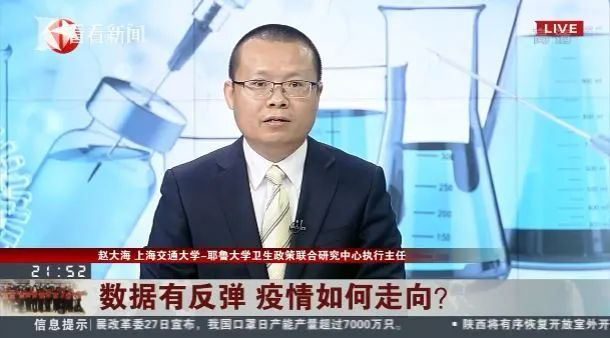上海交大赵大海关于新冠疫情第3次在电视台访谈评论:我国新冠肺炎疫情好转,世界疫情形势严峻

上海交通大学国际与公共事务学院博士生导师、上海交通大学-耶鲁大学卫生政策联合研究中心执行主任赵大海近日第二次做客东方卫视演播厅,也是第三次接受上海电视台的直播采访。在2020年2月27日晚九点半东方卫视《全力抗击新型冠状病毒肺炎疫情》特别报道节目,赵大海就有关国内国际新冠肺炎防控形势进行了直播访谈。
主持人:今天的新冠肺炎新确诊病例数据出现了反弹,主要是湖北以外的地区,那么这样的一个情况,是不是该引起我们的警惕?而且局部的疫情的反弹对整体的防控会带来怎么样的影响?
赵大海:谢谢主持人,应该讲,在全国各地复工复产这个背景之下,出现小幅的反弹是在预料之中的,甚至可以说这种小幅的波动比原先我们预期的要好。
主持人:尤其在复工的这样一个情况下。
赵大海:是的,是的。因此对于整个疫情的防控形势而言,应该讲小幅的反弹不会对于整个疫情的防控带来太大的影响;但有一点,它至少会对全国各地在疫情防控的思想上有一个非常大的警示,这可能是一件坏事变成好事。
主持人:所以会引起我们对这个问题的警戒,包括上海增加了一例以后,大家都神经又紧张起来了。但是也有观点说,因为我们谈到的就是这个整个发病的过程,有不少人认为,如果我们早一点,早到12月的底或者1月初那个时候,采取严格的这种防控措施的话,我们病人的整个病情会大大的减少,大大的缓解,那对于这样的一个分析,您怎么看?
赵大海:首先,这个观点是非常正确的,如果在12月底或1月初相关的部门已经警示出,譬如说新冠肺炎可以人传人的传播,以及当时采取非常严格的措施来阻断这些传播的话,譬如说早发现早隔离,那我们的这个疫情可能不会蔓延到全国,确实这个观点按道理讲是正确的。但是对于本次疫情的防控而言已经没有太大的意义,因为既成事实的是全国已经蔓延了。但是在某种程度上讲,它是一个非常好的警示,就是说未来如果再出现这种急性呼吸道传播的传染性疾病的话,那应该要加强预警系统,应该要做到及时的上报以及及时的来进行审核,和相关的部门包括地方部门及时的来沟通,包括阻断传播,以防止新冠肺炎的第二次爆发,或者说是不明肺炎在中国第三次出现爆发的这种可能,至少我们能做到亡羊补牢。
主持人:而且全世界都非常关注中国的这样一个情况,那么现在我们更关注的可能就是未来了,因为过去的就过去了,未来到底会怎么样?
赵大海:至少是对于本次的这个疫情防控而言,中国除了湖北之外,应该讲是在已在可控的范围之内,全国虽然今天有一个小幅的攀升,但是,依然还有大部分的省市没有新增确诊病例的,应该讲如果目前的这个防控措施不要太大的松懈,应该会在一个月之内全国的大部分省疫情的防控可以说是胜利了;对于湖北而言,按照目前的严格防控措施,可能时间要再长一点,可能要到4月的中下旬;也就是说4月中下旬,中国的整个的新冠肺炎的防控会宣告胜利,但前提是我们整个的防控措施不要松懈,同时还要防止国外的新增病例输入到中国。如果不出现意外的话,应该会在4月中下旬我国整个疫情防控会得到根本性的胜利。
主持人:各国检测的能力不一样,好像标准不一样,它像比如说韩国、意大利、英国它好像是一个做法,但是美国好像它检测一共只检测了大概500个到现在为止,而且日本的反对党也说日本的检测只有韩国的十分之一,那这样不同的检测,是不是检测多了病情好像也就严重了,那检测少的时候,是不是忽略了这个情况,会不会有这种情况?
赵大海:好的,主持人。首先这个问题是跟这个国家的疫情的防控形势和政府的重视程度有关联,譬如说美国现在确诊的病例是60例,其中有40例是来自于“钻石公主号”邮轮,也就是说对于美国而言,现在已发现的确诊病例数相对而言是比较低的,本土的也就20例以内,因此按照惯例只需要对这20例本土病例的密切接触者进行检测就可以了,因此才导致他们的检测人数不是特别多,也就500人左右;另外一个方面,美国CDC也指出他们的试剂盒,各州的标准存在一些问题,也会进一步的来完善这个试剂的标准。还有一个方面的原因和各国的医疗体制,譬如说日本,他们原先的医疗机构是没有办法来开展这个检测工作的。
主持人:对,每个国家的情况都不一样。
供稿单位:国际与公共事务学院
日期:2020年02月28日
Dahai Zhao' 3th comments on TV during the Pandemic: COVID-19 Epidemic Situation is Taking a Turn for the Better in China and the Worser in Other Countries
At 9:30 pm on February 27, 2020, Zhao Dahai conducted live interviews on "Containing COVID-19 Outbreak" program of Dongfang TV about the domestic and international situation of COVID-19 control.
Anchor: Today's newly diagnosed cases have rebounded, mainly in areas outside Hubei. Should such a situation cause our alarm? What impact will the rebound of local outbreaks have on overall prevention and control?
Zhao: It should be said that in the context of the resumption of work and production across the country, a small rebound was expected and even better than we had expected. A small rebound will not bring too much impact on the prevention and control of the whole epidemic. But one thing, at least, it will be a big warning in the minds of people around the country that this can be the good aspect of such a bad news.
Anchor: So it will cause us to alert to this problem, including an additional case in Shanghai, everyone is nervous again. However, there are also opinions that we are talking about the entire process of onset, if we take this kind of strict control measures earlier, as early as the end of December or at the beginning of January, the overall condition will be greatly reduced. What do you think of such an analysis?
Zhao: First of all, this view is very correct. If the relevant departments have warned at the end of December or early January that, for example, COVID-19 can be transmitted from person to person, and that very strict measures were taken at that time to block these transmissions, such as early found and early isolation, then epidemic may not spread to the whole country. Indeed, this view is logically correct. However, it has no significance at this time, because it is a fact that COVID-19 has spread across the whole country. But to a certain extent, it is a very good warning, that is to say, if a such kind of acute respiratory infectious diseases reappear in the future, then the early warning system should be strengthened, and timely reporting and communicate with relevant departments in a timely manner, including blocking transmission to prevent the second outbreak of COVID-19, or the possibility of the third outbreak of another unknown pneumonia in China, at least it is better late than never.
Anchor: The whole world is very concerned about epidemic in China. What will happen in the future?
Zhao: At least for the prevention and control of this epidemic, except for Hubei, China should be said to be within the controllable range. Although the country has seen a slight increase today, most provinces still have no new increased cases. It should be said that if the current prevention and control measures are not too lax, it should be a victory in most provinces in the country within one month. For Hubei, according to the current strict prevention and control measures, it may take a little longer, and it may not be until mid-to-late April. That is, China’s entire prevention and control of COVID-19 will declare victory. But only when our entire prevention and control measures will not be lax, and prevent imported cases from outside China at the same time. If there are no accidents, the whole country's epidemic prevention and control will win a fundamental victory in mid-April.
Anchor: Different countries have different detection capabilities, as if the standards are not the same. Such as South Korea, Italy, and the United Kingdom, it seems to be a practice. But in the United States, they have detected only about 500 cases. So far, and the Japanese Democratic Party also said that their detection were only one-tenth of that in South Korea. Does such a difference in detection affect the detection and estimation of their condition?
Zhao: First of all, this problem is related to the situation of the country's epidemic prevention and control. For example, 60 cases are currently diagnosed in the United States, of which 40 are from the "Diamond Princess" , which means that as far as the United States is concerned, the number of confirmed cases is relatively low, and the number of local cases is less than 20. Therefore, only close contacts of these 20 local cases are required to be checked, so the number was not particularly large,at about 500. On the other hand, the CDC in the United States also pointed out that there are some problems with the standards of each state, and it will further improve the standard of diagnose kit. There is another reason of the health care systems of various countries, such as Japan, their original medical institutes cannot carry out this test.
Contributor: SJTU School of International and Public Affairs
Data: February 28, 2020

